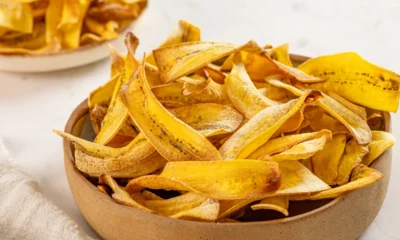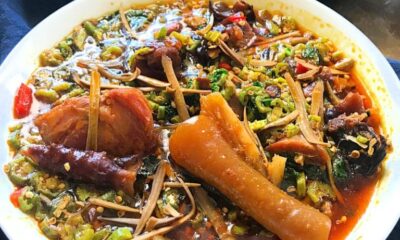FOOD
How To Cook Nigerian Goat Meat Pepper Soup
Published
12 months agoon
By
wpadminee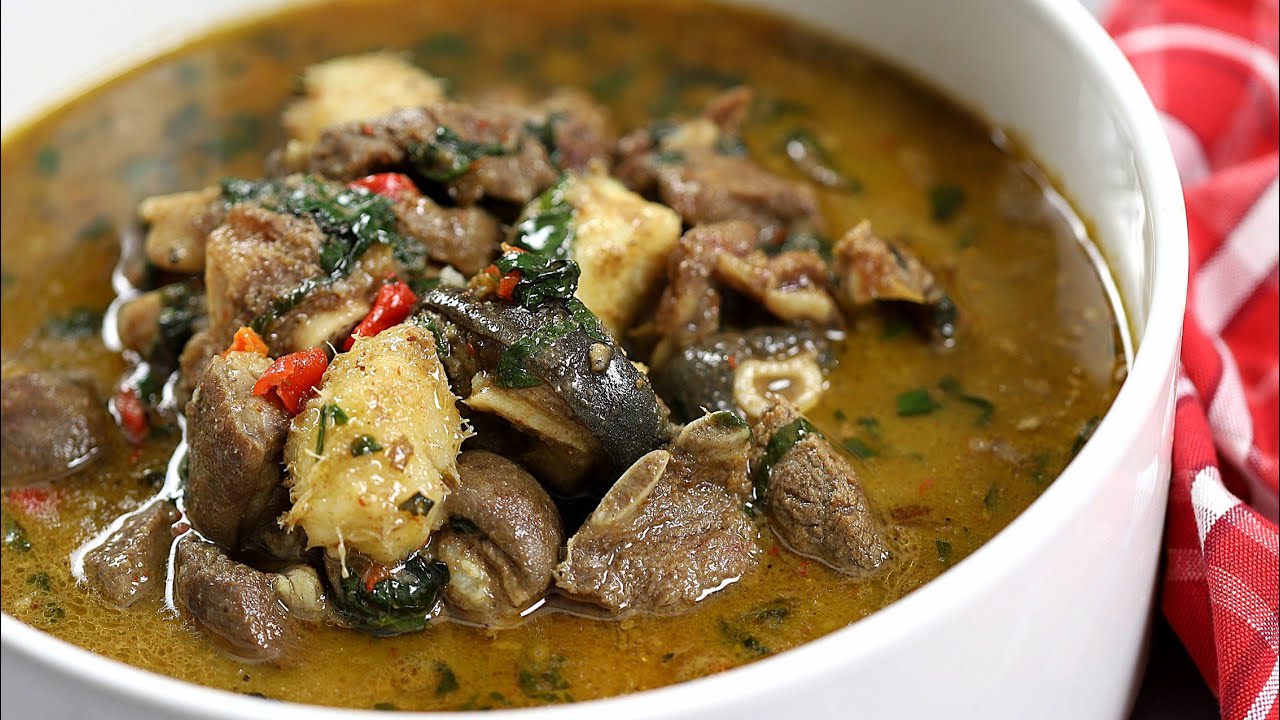
Nigerian pepper soup is a spicy soup traditionally made in West Africa. It has various meats or fish, vegetables, and strong spices. Today, we’ll learn a favourite version: Nigerian goat meat pepper soup with white yam!
This recipe adds a twist by including yam chunks directly in the soup for a complete, hearty meal. You can also boil the yam separately and serve it on the side.
Pepper soup is known for its powerful kick—it’s very spicy. But it’s also incredibly flavorful, and it uses healthy spices and herbs. These spices are perfect for cold weather. Some even have natural cold- and flu-fighting properties.
Unlike thicker soups like okra or egusi, pepper soup is meant to be enjoyed on its own. You can also eat it with simple sides, like boiled white yam.
If you’ve never tried Nigerian pepper soup, get ready for an unforgettable experience! This goat meat and yam combo is packed with flavour and will transport you straight to Nigeria with every delicious bite.
What is Nigerian pepper soup spice made of?
This recipe uses a special spice mix that gives Nigerian pepper soup its authentic flavour. The mix includes African calabash nutmeg (Ehuru in Igbo), grains of Selim (Uda in Igbo), and alligator pepper. You can find this spice mix already made at most African stores or online. It’s usually gluten-free and sodium-free, but always check the label to be sure.
The spice mix is very spicy, so be careful when adding it to your soup. Start with a small amount, like a tablespoon, and taste as you go. You can always add more later if you need it.
Ultimately, you control how spicy your pepper soup is. On top of the spice mix, this recipe also uses scotch bonnet peppers, which are another source of heat in the soup.

Ingredients for goat meat yam pepper soup
For this Nigerian pepper soup, you’ll need:
- Protein: Goat meat (or your preferred protein)
- Vegetables: African Yam (Nigerian yam tuber, recommended for freshness and available at African stores)
- Spices and flavourings:
- Natural, sodium-free Nigerian pepper soup spice mix
- Fresh scotch bonnet peppers (be careful, they’re spicy!)
- Red bell peppers
- Chopped onions
- Knorr Bouillon Chicken seasoning
- Dry crawfish (optional, for a seafood flavour)
- Utazi leaves (use sparingly; they’re bitter)
- Basil leaves (optional; adds freshness)
- Fresh ginger (optional, recommended)
- Extra virgin olive oil (optional, for sautéing vegetables)
- Salt: To taste
How to prepare Nigerian goat meat pepper soup
To begin, gather the essential ingredients, including the ultimate Nigerian pepper soup spice, which is crucial for an authentic flavour. You’ll also need vegetables like onions, bell peppers, and fresh bonnet peppers.
When selecting bonnet peppers, keep in mind that they are very hot and spicy. If you prefer a milder flavour, you can substitute them with other spicy peppers, like jalapenos.
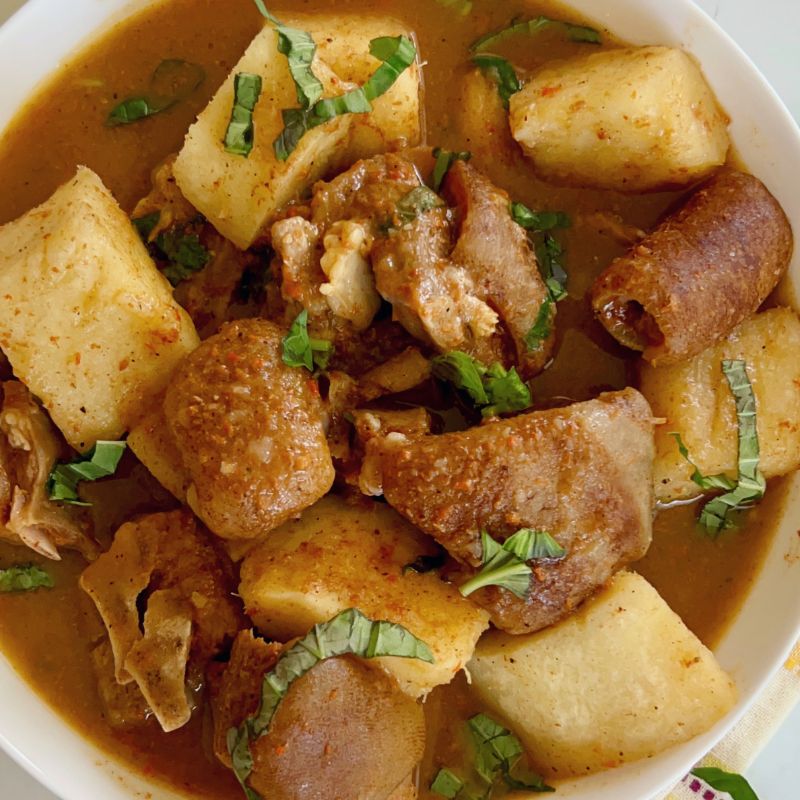
These ingredients will add depth and heat to your pepper soup, creating a delicious and satisfying dish that’s perfect for any occasion.
1. Gather your ingredients
Before you start cooking, you must ensure you have all the necessary ingredients on hand. For this recipe, you’ll need goat meat, bell peppers, onions, scotch bonnet peppers, dry crawfish, salt, Knorr Bouillon Chicken seasoning, African yam tuber, fresh ginger, Nigerian spice (pepper soup spice), olive oil (optional), and basil leaves.
2. Wash, cut, and blend the vegetables
Start by washing the bell peppers and onions thoroughly. Then, cut them into chunks and add them to a blender. Similarly, wash the scotch bonnet peppers and remove the seeds if desired for a milder flavour.
Add them to the blender along with the dry crawfish. Blend everything with some water until you achieve a smooth consistency.
3. Wash and clean the goat meat
Properly wash and clean the goat meat under cold, running water. You must ensure that the meat is free from any impurities. If the meat is frozen, thaw it completely before washing. Once washed, pat it dry with paper towels and place it in a clean pot.
4. Starting with the meat, cook your Nigerian goat meat pepper soup
Pour the blended vegetable mixture over the goat meat in the pot. Season the meat with salt and Knorr Bouillon Chicken seasoning according to your taste preferences.
Cover the pot and let the meat cook on medium heat. Stir occasionally to ensure that all the ingredients are well combined.
Allow it to cook for about 30 minutes until the meat is partially tender.
5. Prepare the yam
While the meat is cooking, wash, peel, and cut the African yam tuber into sizeable chunks. Keep the yam pieces in cold water to prevent them from turning brown.
If you have sensitive skin, you should wear gloves while handling and cutting the yam to avoid discomfort or itching.
6. Add pepper soup spice and water
After the meat has cooked for 30 minutes, grate fresh ginger into the pot for added flavour. Then, add water and the Nigerian spice (pepper soup spice) to the pot. If desired, you can also add a tablespoon of olive or vegetable oil for richness.
Stir everything well to ensure that the flavours are evenly distributed. Cover the pot and let it simmer for another 35–45 minutes to allow the flavours to meld together.
7. Add the yam to finish up cooking
Once the meat is tender and infused with the flavours of the spices, drain the water from the yam chunks and add them to the pot. Stir gently to combine the yam with the soup. Cover the pot and let the yam cook for about 10–20 minutes until it becomes tender.
Finally, add sliced or chopped basil leaves to the soup for a fresh burst of flavour. Taste the soup and adjust the seasoning if necessary.
By following these detailed steps, you’ll be able to prepare a delicious and authentic Nigerian goat meat pepper soup that’s bursting with flavour and perfect for any occasion.

Some important tips to keep in mind when making this pepper soup
- The cooking time for your pepper soup may vary depending on the size of the meat chunks you cut. Larger pieces will take longer to cook than smaller ones.
- Pepper soup spice is known for its heat, so add it according to your taste preference. You can adjust the amount to make your soup more or less spicy.
- If you’re planning to meal-prep your pepper soup, you may want to skip adding yam directly to the soup. Instead, boil the African yam tuber separately. Once cooked, you can add the boiled yam and pepper soup to separate freezer-friendly containers before freezing for easy storage.
- Ensure you use a high-quality, all-natural Nigerian pepper soup spice for the best flavour. Look for options that are gluten-free and sodium-free, especially if you have dietary restrictions.
How to serve Nigerian goat meat pepper soup
- Combining goat meat pepper soup with African yam tubers creates a delicious pairing that many consider heavenly. Yam pepper soup is especially beloved and can elevate your next pepper soup experience.
- In Nigerian culture, pepper soup is commonly served as an appetiser in restaurants and homes. It’s a favourite among enthusiasts like myself, and while it’s often enjoyed during colder weather, it’s actually a year-round delight.
- Pepper soup can be served on its own or paired with other dishes like Nigerian Agidi (corn flour jelly), offering versatility in serving options to suit different preferences.
- For the best flavour and experience, it’s recommended to enjoy pepper soup while it’s still warm or slightly hot. Reheating it before serving ensures you get the full richness of the spices and ingredients.
If you enjoyed reading this article, you can check here for more articles on food.
For a visual tutorial, watch this.
FOOD
4 Tips For A Stress-Free Cooking Experience This Christmas
Published
4 months agoon
December 22, 2024By
wpadminee
The Christmas season is a time for joy, family, and delicious meals. However, cooking can often feel overwhelming, especially with the holiday hustle. With the right approach, cooking Christmas meals can be a stress-free experience.
Here are four practical tips for a stress-free cooking experience this Christmas.
1. Plan Ahead for Every Detail
Preparation is the key to success in the kitchen. Start by creating a detailed menu. Write down the dishes you want to make, the ingredients you need, and the estimated time for each recipe. This planning ensures you stay organised.
Invest time in grocery shopping early. Stores can be crowded closer to Christmas, so getting what you need in advance helps avoid the rush.
Batch-process tasks like peeling vegetables or marinating meat a day or two before. Following these tips for stress-free cooking keeps last-minute chaos at bay.
2. Simplify Your Menu
Christmas meals don’t need to be extravagant to be memorable. Focus on a few key dishes that everyone loves rather than a spread that leaves you exhausted. Choose recipes that are easy to prepare and don’t require constant attention.
For desserts, consider make-ahead options like pies or cookies. These can be prepared in advance, allowing you to spend more time with your guests. Simplifying your menu is one of the best tips for stress-free cooking this Christmas.
3. Use Time-Saving Tools and Techniques
Modern kitchen gadgets are lifesavers during Christmas. Slow cookers, food processors, and stand mixers can help speed up the process while reducing effort.
For large meals, use your oven efficiently. Bake multiple dishes at once if they require the same temperature. Pre-chop ingredients or buy pre-cut options to save valuable time.
Embrace these tips for stress-free cooking to make your holiday meal prep smoother and faster.
4. Delegate and Involve Others
You don’t have to do everything yourself. Share the workload with family or friends. Assign simple tasks like setting the table, washing vegetables, or stirring sauces to others.
If guests offer to bring a dish, accept their help. Potluck-style dinners reduce your cooking burden while adding variety to the table.
Delegating responsibilities is among the most effective tips for stress-free cooking, ensuring you enjoy the process too.
Cooking for Christmas doesn’t have to be a source of stress. By planning ahead, simplifying your menu, using time-saving techniques, and involving others, you can create a joyful and memorable meal.
These four tips for stress-free cooking will not only lighten your load but also let you focus on the true spirit of the season: togetherness and gratitude.
Keep these strategies in mind as you prepare your holiday feast. Merry Christmas and happy cooking!
For more reads, visit here.
FOOD
3 Delicious Recipes For Making Akidi (Black Beans)
Published
4 months agoon
December 8, 2024By
wpadminee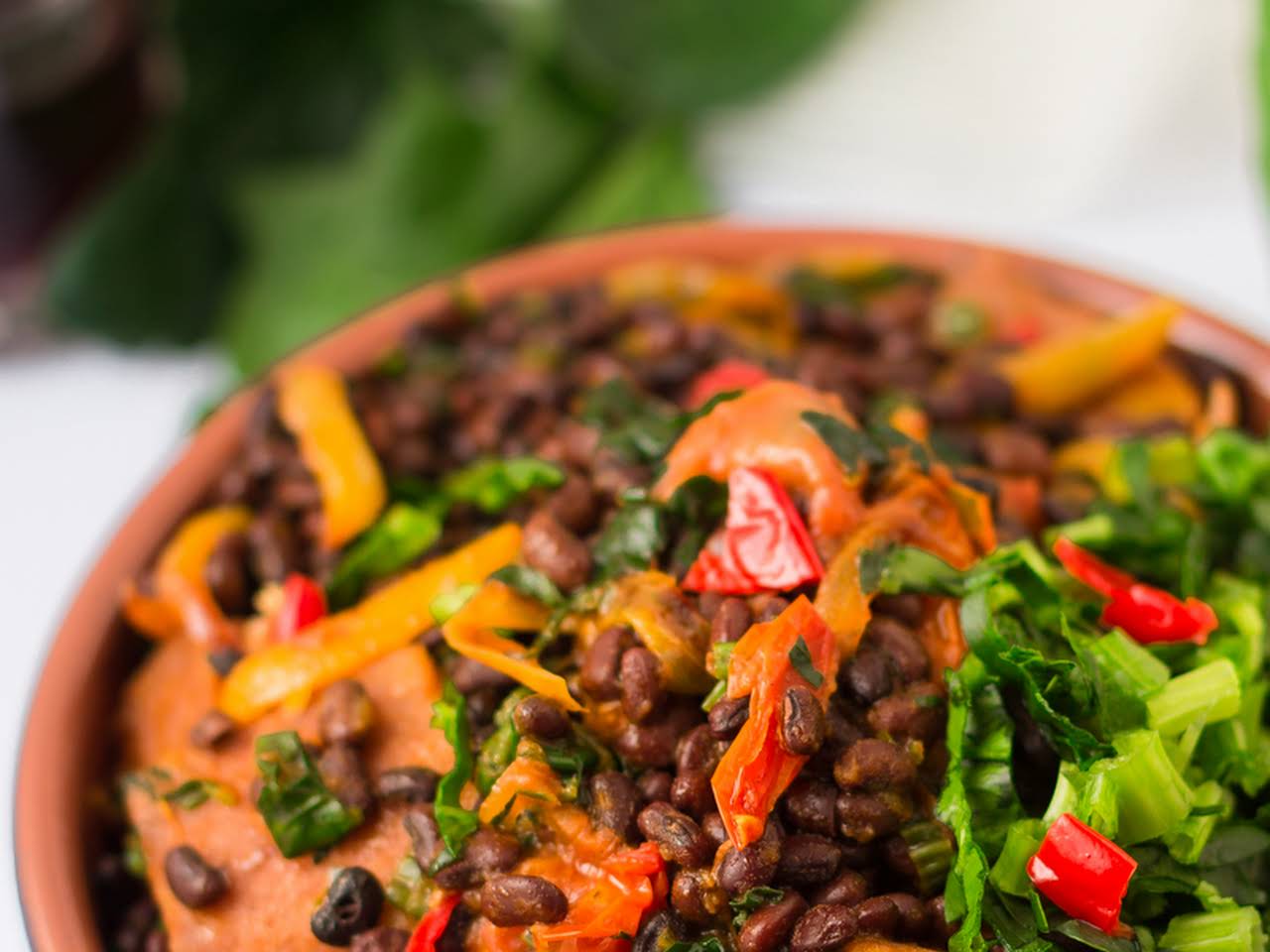
Akidi (black beans) recipes are a cornerstone of Enugu State’s culinary heritage, enjoyed widely across Nigeria and Africa. This versatile legume, rich in protein, fibre, and essential vitamins, makes it a nutritious staple in many homes.
Originating from Enugu, akidi holds a special place in traditional dishes, offering robust flavour and health benefits.
If you’re looking to expand your cooking repertoire, these three delicious akidi (black beans) recipes will elevate your meals.
Whether you’re an experienced chef or a kitchen novice, each akidi (black beans) recipe provides a unique taste experience.
Embrace the richness of Enugu’s culture and impress your family with these flavourful and nutritious dishes featuring the beloved black beans.
Recipe 1: Classic Akidi Soup
Ingredients:
- 1 cup dried black beans (akidi)
- 1 large onion, chopped
- 2 scotch bonnet peppers, chopped
- 2 tablespoons palm oil
- 1 teaspoon dried crayfish
- 1 teaspoon salt
- 1/2 teaspoon black pepper
- 1 stock cube
- Water
Instructions:
- Soak the beans: Rinse the black beans and soak them in water overnight.
- Cook the beans: Drain the soaked beans and add them to a pot with fresh water. Bring to a boil, then reduce heat and simmer until the beans are tender.
- Sauté the aromatics: Heat the palm oil in a separate pot. Add the chopped onion and scotch bonnet peppers, and sauté until fragrant.
- Combine the ingredients: Add the sautéed ingredients to the pot of cooked beans. Stir in the dried crayfish, salt, black pepper, and stock cube.
- Simmer and serve: Simmer the soup for an additional 10-15 minutes, or until the flavours are well combined. Serve hot.
Recipe 2: Akidi with Spinach and Plantain

Ingredients:
- 1 cup cooked black beans (akidi)
- 1 bunch spinach, chopped
- 2 ripe plantains, sliced
- 1 onion, chopped
- 2 cloves garlic, minced
- 1 teaspoon ginger, grated
- 1 teaspoon curry powder
- 1/2 teaspoon turmeric powder
- Salt to taste
- Vegetable oil
Instructions:
- Heat the vegetable oil in a pot. Add the onion, garlic, and ginger, and sauté until fragrant.
- Add the spinach: Add the chopped spinach to the pot and stir until wilted.
- Combine the ingredients: Add the cooked black beans, curry powder, and turmeric powder to the pot. Stir to combine.
- Fry the plantains: In a separate pan, fry the plantain slices until golden brown.
- Serve: Serve the akidi and spinach mixture with the fried plantains.
Recipe 3: Akidi with Smoked Fish and Vegetables

Ingredients:
- 1 cup cooked black beans (akidi)
- 1 smoked fish, crumbled
- 1 large onion, chopped
- 2 carrots, diced
- 1 green bell pepper, diced
- 1 teaspoon thyme
- 1/2 teaspoon black pepper
- Salt to taste
- Vegetable oil
Instructions:
- Heat the vegetable oil in a pot. Add the onion, carrots, and bell pepper, and sauté until softened.
- Add the beans and smoked fish: Add the cooked black beans and crumbled smoked fish to the pot. Stir to combine.
- Season and simmer: Season with thyme, black pepper, and salt. Simmer for 10-15 minutes, or until the flavours are well-combined.
- Serve: Serve the akidi with smoked fish and vegetables hot with rice, yam, or bread.
These three akidi (black beans) recipes are just a starting point. Feel free to experiment with different ingredients and flavours to create your own unique dishes.
Remember, the key to a delicious akidi dish is to use high-quality ingredients and to cook slowly to allow the flavours to develop.
Whether you’re a seasoned cook or a novice in the kitchen, these akidi (black beans) recipes are a great way to enjoy this nutritious and flavourful legume.
For more articles on food recipes, visit here.
FOOD
5 Health Benefits Of Cooking With Garlic
Published
4 months agoon
December 7, 2024By
wpadminee
Garlic is more than just a flavour enhancer; it offers numerous health benefits that have been celebrated for centuries. Incorporating garlic into your meals not only enriches the taste but also boosts your overall well-being.
Let’s explore five key health benefits of garlic, emphasising why this simple ingredient deserves a spot in your kitchen.
1. Boosts Heart Health
Garlic is renowned for its heart-protective properties. It helps lower blood pressure and reduces cholesterol levels, which are crucial factors in maintaining cardiovascular health.
Allicin, a compound found in garlic, relaxes blood vessels, improving blood flow and reducing the risk of heart disease.
Regular consumption of garlic may also prevent artery hardening, a condition known as atherosclerosis. Clearly, one of the primary health benefits of garlic is its contribution to a healthy heart.
2. Strengthens the Immune System
Garlic acts as a powerful immune booster. Its antibacterial, antiviral, and antifungal properties help the body fend off infections. Rich in antioxidants, garlic combats free radicals that can damage cells and contribute to illness.
Cooking with garlic regularly can support your immune system, making it more resilient against common colds and flu. This vital health benefit of garlic makes it a natural defence mechanism.
3. Improves Digestive Health
Garlic promotes healthy digestion by stimulating the production of digestive enzymes. Its antimicrobial properties can help balance gut flora, reducing harmful bacteria and promoting beneficial ones.
Additionally, garlic may reduce inflammation in the gut, alleviating symptoms of conditions like irritable bowel syndrome (IBS).
Including garlic in your diet can improve overall digestive function, emphasising another essential health benefit of garlic.
4. Enhances Bone Health
Surprisingly, garlic may also support strong bones. It contains minerals like calcium, manganese, and selenium, which are vital for bone density and strength.
Some studies suggest that garlic consumption can increase estrogen levels in women, potentially reducing the risk of osteoporosis.
This lesser-known health benefit of garlic highlights its role beyond the kitchen, contributing to long-term skeletal health.
5. Supports Detoxification
Garlic aids the body’s natural detoxification process by activating liver enzymes that help eliminate toxins. Its sulfur compounds enhance liver function, enabling the body to flush out heavy metals and harmful substances more efficiently.
Regularly cooking with garlic can provide a natural cleanse, supporting overall vitality. This detoxifying health benefit of garlic underscores its importance for maintaining internal balance.
Incorporating Garlic into Your Diet
Maximise these health benefits by adding garlic to soups, stir-fries, and sauces. Crush or chop it and let it sit for a few minutes before cooking to enhance its beneficial compounds.
Remember, the health benefits of garlic are most potent when it’s used fresh and minimally cooked.
Cooking with garlic not only elevates your culinary creations but also offers significant health advantages. Embrace this versatile ingredient and enjoy the multiple health benefits of garlic with every meal.
Would you like more articles or additional tips? Check here.
Latest


Samsung Galaxy S25 Series Sets The Standard Of AI Phones As A True AI Companion
Samsung Galaxy S25 series sets the standard of AI phones as a true AI companion …Pioneering the multimodal era with...


5 Things To Expect In Afrobeats In 2025
Afrobeats is poised to reach unprecedented heights in 2025 as Nigerian music continues its remarkable global ascent. The genre’s explosive...


Here Are The 7 Most Ancient Countries On Earth
The oldest countries in the world stand as remarkable testaments to human civilisation, each containing landscapes and monuments that narrate...


Why Self-Reflection Is More Important Than Resolutions
Millions of people embark on a yearly ritual: they sit down with a notebook and pen, eager to craft a...


Nollywood Director, Kemi Adetiba Teases King Of Boys 3
Nollywood director Kemi Adetiba has revealed that another instalment of King of Boys will be released on December 25, 2025....


John McEnroe Says He Can Be The Commissioner Tennis Needs Amid Doping Crisis
Recent doping controversies involving top players have not damaged tennis’s reputation, but John McEnroe believes that appointing a single commissioner...


“Everybody Loves Jenifa” Becomes Nollywood’s Highest-Grossing Film Of All Time
Nollywood filmmaker Funke Akindele has achieved a historic milestone with her latest film, “Everybody Loves Jenifa.” The film has officially...


FG To Premiere TV Series, “Hidden Riches” On Mining Sector On January 25
Nigeria’s Federal Government will launch an ambitious television drama series focused on the nation’s mining sector, premiering “Hidden Riches” on...


Qing Madi Delivers A Soulful Performance Of “Favourite Pyscho”
Rising Afro-RnB sensation Qing Madi launches into 2025 with a mesmerising performance on the prestigious COLOURS platform, showcasing her latest...


Taiwo Awoniyi’s First Goal Of The Season Seals Nottingham Forest’s Win Over Wolves
Taiwo Awoniyi made a triumphant return to Premier League action. He scored in stoppage time to help Nottingham Forest crush...
-Ad-





